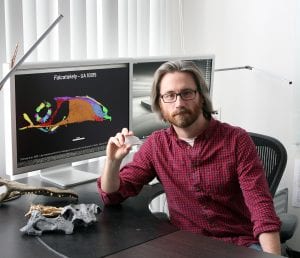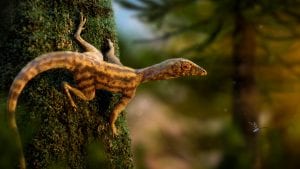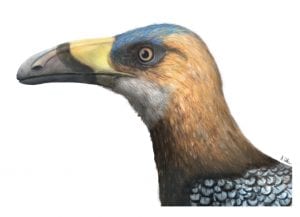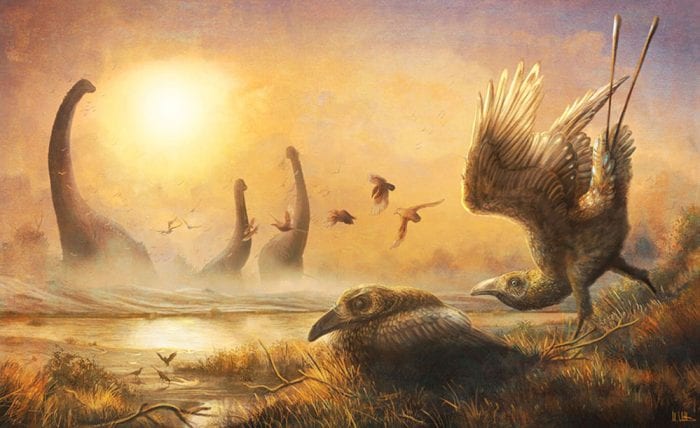By Daniel Dunaief
Dromomeron and Falcatakely lived nowhere near each other. They also lived millions of years apart, offering the kind of evolutionary pieces to different puzzles that thrill paleontologists.

These two creatures, the first a three-foot long dinosaur precursor discovered in Ghost Ranch, New Mexico, and the second a crow-sized bird fossil discovered in Madagascar, have taken center stage in recent scientific circles.
What they have in common is Alan Turner, Associate Professor in the Department of Anatomical Sciences at the Renaissance School of Medicine at Stony Brook University.
The discoveries, which were made over a decade ago, were recently parts of publications in consecutive issues of the prestigious journal Nature. “It’s really exciting,” Turner said. “I definitely feel fortunate” to contribute to these two publications.
Turner, who is not the lead author in either study, emphasized that these papers were only possible through teamwork. “These large, collaborative efforts are one of the ways these really significant discoveries can happen,” he said.
The work that includes Dromomeron, in particular, is one that “any one of our groups couldn’t have done [alone]. It hinged on a series of discoveries across multiple continents.”
Each paper helps fill out different parts of the evolutionary story. The Dromomeron discovery helps offer an understanding of a major evolutionary transition from the Triassic Period, while the Falcatakely find offers a look at the diversification of birds during the Cretaceous Period.
Dromomeron
Starting with the paper in which Dromomeron appears, researchers used a collection of dinosaur precursor fossils to study a smaller group of animals called lagerpetids, whose name means “rabbit lizard” or “rabbit reptile.”
These creatures lived during the age of the earliest relatives of lizards, turtles and crocodylians.

Pterosaurs, which have a characteristic elongated fourth finger that forms a large portion of their wing, lived 160 million years ago, which means that the earlier, flightless lagerpetids roamed the Earth about 50 million years before pterosaurs.
Turner discovered Dromomeron in Ghost Ranch, New Mexico 14 years ago. Since then, other scientists have unearthed new bones from this prehistoric rabbit lizard group in North America, Brazil, Argentina and Madagascar.
Scientists involved in this paper used micro-CT scans and 3D scanning to compare lagerpetid and pterosaur skeletal fossils to demonstrate overlaps in their anatomy. The shape and size of the brain and inner ear of these lagerpetid fossils share similarities with pterosaurs.
The inner ear, Turner explained, is particularly important for animals like the pterosaur, which likely used it the way modern birds do when they are in flight to help determine their location in space and to keep their balance.
Lagerpetids, however, didn’t fly, so paleontologists aren’t sure how these ancient rabbit lizards used their inner ear.
Turner said the Dromomeron discovery was initially more of a curiosity. In fact, when researchers found it, “we had a blackboard in this collection space where we were working,” Turner recalled. “It was unceremoniously referred to as ‘Reptile A.’ There weren’t a lot of things to compare it to. At that point we knew we had a thing but we didn’t know what it was.”
A colleague of Turners, Randall Irmis, Chief Curator and Curator of Paleontology, Associate Professor of Geology and Geophysics at the University of Utah, traveled to Argentina, where he noticed a creature that was similar to the find in New Mexico.
Irmis’s trip “allowed our team to confirm our comparison [between Dromomeron and Lagerpeton] first-hand. From there, we were able to build out the larger evolutionary context,” Turner explained in an email.
Falcatakely
Meanwhile, Turner and Patrick O’Connor, Professor of Anatomy and Neuroscience at Ohio University and lead author on the study, shared their discovery of a bird they located in Madagascar that they called Falcatakely.
The bird’s name is a combination of Latin and Malagasy, the language of the island nation of Madagascar, which means “small scythe” and describes the beak shape.

The scientists found a partial skull in a quarry in Madagascar. The fossil was embedded in rocks. Turner and O’Connor analyzed it through CT scanning and through careful physical and digital preparation by their colleague Joe Groenke, laboratory coordinator for the O’Connor lab.
The discovery of grooves on the side of the face for a beak took the researchers by surprise.
“As the face began to emerge from the rock, we immediately knew that it was something very special, if not entirely unique,” O’Connor said in a press release.
“Mesozoic birds with such high, long faces are completely unknown, with Falcatakely providing a great opportunity to reconsider ideas around head and beak evolution in the lineage leading to modern birds.”
As with the Dromomeron find, the discovery of Falcatakely didn’t provide a eureka moment when the scientists found it 10 years ago.
“We didn’t know [what we had] when we collected this material,” Turner said. “It wasn’t until we CT scanned the block in an effort to begin the preparation that we said, ‘Wait a second. There’s something really weird in this block. The flat part turned out to be the side of the face.”
Turner originally thought it could have been the breast bone of a larger dinosaur. During the pandemic, he has come back to projects that have been sitting around for several years. Some have “probably danced on the periphery that have now come to the dance,” in terms of his focus.
In looking back on the ingredients that made these two Nature papers possible, Turner added another element. These publications underline “the importance of investing in long term field work expeditions,” he said.





